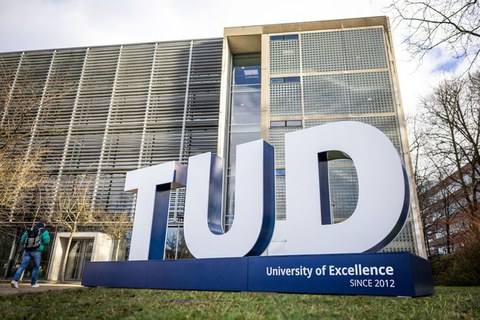Lobet das Handwerk!
(befragt im Jahr 2024)
Thomas Scheufler
Konstantin Scholz ist diplomierter Architekt, Meister des Schilder- und Lichtreklamehersteller-Handwerks, arbeitet in der Werbetechnikfirma seines Vaters, plant diese perspektivisch übernehmen und hat den neuen Fotospot aus drei XXL 3D-Buchstaben am Hörsaalzentrum der TU Dresden erstellt.

Konstantin Scholz ist der Absolvent des Monats Juli 2024.
| Profil von | Konstantin Scholz |
| Studiengang | Architektur |
| Fakultät | Architektur |
| Studienzeit | 2009 bis 2017 |
| Aktuelle Tätigkeit | Werbetechniker |
Warum haben Sie sich für ein Studium an der TU Dresden entschieden?
Mein Wunsch war es in erster Linie, Produktdesign zu studieren. Allerdings hatte ich die Aufnahmeprüfungen an der Bauhaus-Uni in Weimar und der Burg Giebigenstein in Halle nicht auf Anhieb geschafft. Da ich aber unbedingt studieren wollte und über Freunde bereits Einblicke in das Grundstudium der Architektur hatte, entschied ich mich für das Studium der Architektur an der TU Dresden.
Wieso haben Sie gerade diese Studienrichtung gewählt?
Wie bereits erwähnt, waren es die ersten Einblicke in die Aufgabenstellungen des Grundstudiums meiner Freunde, die meiner Entscheidung auf die Sprünge halfen. Meinen Neigungen und Fähigkeiten im Zeichnen, körperhaften Darstellen und kreativ-schöpferischen Denken konnte ich in diesem Studiengang nachgehen. Weil mir diese Dinge Spaß machen, konnte ich sie mit Leidenschaft und Überzeugung ausüben. Gerade im Grundstudium liegen die Studienrichtungen Design, Produktdesign, Architektur und Kunst noch recht nah beieinander.
Wer aus Forschung und Lehre hat Sie in Ihrer Studienzeit am meisten geprägt?
Drei Professuren sind mir in besonderer Erinnerung geblieben. Zum einen war es Darstellungslehre mit Dr. Tom Schoper und Prof. Niels-Christian Fritsche. Sie zeigten uns – in erste Linie zeichnerisch – wie Proportionen, Räumlichkeit, Farbe, aber auch Schrift und Bild aufgebaut sind. Auf diesen Grundlagen, die wir handwerklich – weniger theoretisch – beigebracht bekamen, baut mein heutiges Wissen über die Möglichkeiten und das Verständnis von Darstellung auf. Darauf greife ich fast täglich in meinem Berufsalltag zurück. Entwürfe, Aufmaße, zeichnerische Erläuterungen bei Kunden- und Mitarbeitergesprächen fallen mir durch diese Lehre leicht. Darüber hinaus schaffte die Professur gekonnt den Spagat von zeichnerisch-räumlichen Darstellungen hin zu digitalen dreidimensionalen Aufgabenstellungen. Die Herausforderung, zeichnerisch Zusammenhänge zu begreifen und darzustellen ist für mich eines der erfüllendsten Bestandteile des Studiums gewesen. Zum anderen war es die Professur für darstellende Geometrie unter Prof. Daniel Lordick. Hier haben wir gewissermaßen die Darstellungslehre mathematisch vertieft, somit fundiertes Wissen und Sicherheit erlangt, dreidimensionale Gebilde auf Papier wiederzugeben. Ein I-Tüpfelchen war ein Kurs an dieser Professur für 3D-Modelling. Hier hatten wir die Möglichkeit, Einblicke in die Welt zu bekommen. Und zu guter Letzt Baugeschichte. Wer die Vorlesungen von Prof. Hans-Georg Lippert miterlebt hat, darf sich glücklich schätzen. Der Saal war immer gerammelt voll.

Seit Januar 2024 sind die 3-D-Buchstaben im XXL-Format ein Fotomotiv auf der Wiese hinter dem Hörsaalzentrum. Geschaffen hat sie Konstantin Scholz mit seiner Firma.
Wo sind Sie heute beschäftigt, und in welcher Verantwortung?
Ich arbeite als Werbetechniker in der Firma meines Vaters mit dem Ziel, das Unternehmen zukünftig weiterzuführen.
Was würden Sie den heutigen Studienanfängerinnen und -anfängern mit auf den Weg geben?
Wenn ich mich noch einmal für ein Studium entscheiden dürfte, würde ich versuchen, dual zu studieren. Die Praxis fehlt beim Einstieg ins Arbeitsleben. Dieser Umstand wirkt lähmend und kann sich unter Umständen wie ein Rückschritt anfühlen. Es ist aber ebenso schwierig, neben dem Uni-Alltag arbeiten zu gehen. Deshalb wäre für mich ein duales System der ideale Weg!
Woran erinnern Sie sich besonders gern in Ihrer Studienzeit?
Entwürfe, Projektarbeiten in großräumigen Studios – damals im alten Fritz-Foerster-Bau – mit Strom, Internet und gefühlt 2m² Tischfläche zum Arbeiten (unter anderem).
Wo war Ihr Lieblingsort an der Uni?
Das Studio im alten Fritz-Foerster-Bau und das Hörsaal-Zentrum.
Wovon profitieren Sie noch heute/ hätten Sie sich mehr gewünscht?
Zusammenhänge von der Lehre der Architektur und die Möglichkeit, diese oder Aspekte davon darzustellen, erleichtert mir das tägliche Arbeiten. Die Fakultät braucht dringend (Stand 2017) wieder große Studios, in denen die Studierenden gut arbeiten können. Austausch und Platz waren nach zwischenzeitlicher Schließung des Fritz-Foerster-Baus nicht mehr so einfach möglich. Aus meiner Sicht sind diese Dinge für die zukünftige Entwicklung unabdingbar.
Wie gelingt ein guter Berufseinstieg in Ihrer Branche?
Offenheit und Interesse für das Handwerk und die Handwerker. Nicht den Schritt scheuen evtl. nochmal in die Meisterlehre zu gehen. Das hat mir extrem geholfen.
Was verbindet Sie heute mit der TU Dresden?
Erinnerungen an eine herrliche Studienzeit und die Freude über die kürzlich von Dresden Design gebauten 3D-Buchstaben vor dem HSZ.
Kontakt:
TUD-Filmclips zum Studium der Architektur:
